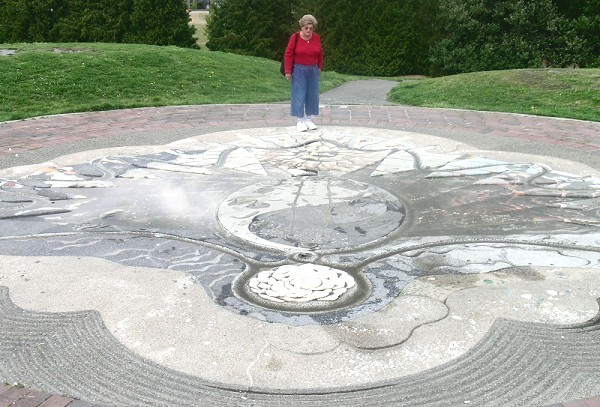
Analemmatic dials
Gasworks Park, Seattle (Washington, USA)

It requires more than a casual look to recognize the paving that tops Kite Hill as a sundial. At first glance, it seems as if the high tide washed over a bed of fresh concrete, leaving lots of marine creatures and wave prints behind. A colleague of mine lived in Seattle for two years, only two blocks away. He loved to go here for jogging, sun bathing or picnics. Only after I showed him these pictures he remembered vaguely that there was 'something' on top of the hill.
In fact it is an analemmatic sundial, embedded in an intricate piece of artwork. It was created by artists Charles Greening and Kim Lazare. Dick Tobiason of Bend, Oregon, stimulated me to add this sundial, which would be "the most ornate" on my website. He sent me nearly all the pictures you see here.
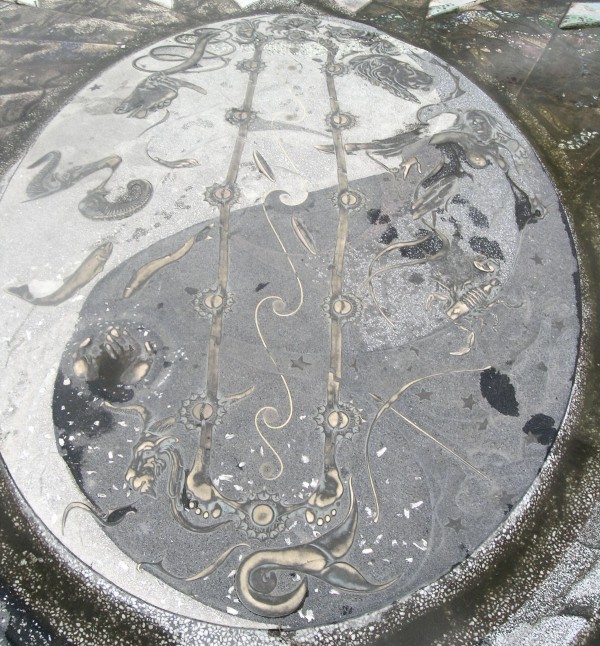
The centerpiece is a large yin-yang symbol, made from light and dark concrete. An elongated bronze band loops around a wavy center line, running north-south. In more down-to-earth dials, the date scale is found here. The signs of the zodiac are represented by beautifully carved bronze inlays alongside the band, among lots of marine organisms. In the above photo, looking north, one sees Capricornus (Goat) in the bottom and to the right the bow of Sagittarius (Archer) and Scorpio. Some other pretty creatures are depicted below: Leo (Lion) and Cancer (Crab).
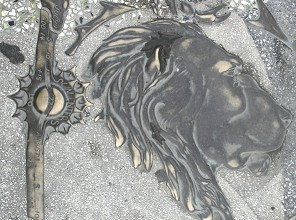 |
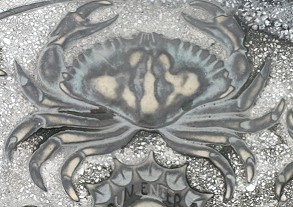 |
Humorously represented is Virgo (the voluptuous Virgin), as if immersed in her bathtub, while Aquarius (Waterman) almost disappears below the surface.
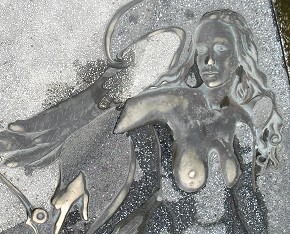 |
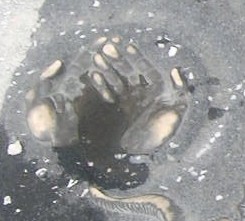 |
From the yin-yang symbol, overlapping triangles radiate out. They point to the hour numbers, which read local time. As far as I can note from the photos, the concrete is quite colorful and is also adorned with pieces of tile mosaic. The hours run from 5 a.m. to 7 p.m.. They too are colorful. The 8 a.m. number is quite cheerful, signalling the happy time to leave for school or work. And the 5 p.m. number is set in a sparkling blue mosaic, promising a peaceful evening.
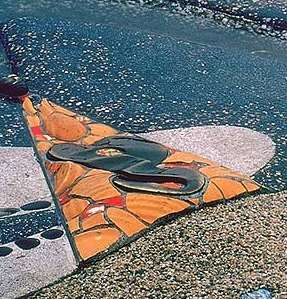 |
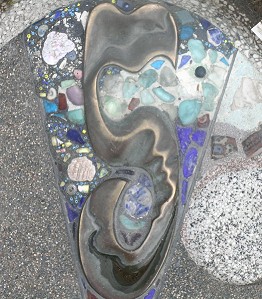 |
A spiral design, reminiscent of a transected snail's shell, is inserted between the center piece and the hour points. Golden flakes spiral outward in the outer coil. Tentacles as from a multipoded octopus run outward from here over the triangle-covered area.
At the other side of the center piece a rose-like design is laid out. A wavy, snake-like groove crawls around the entire dial face, zigzagging between the hour numbers.
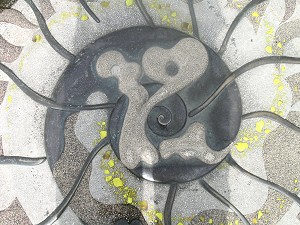 |
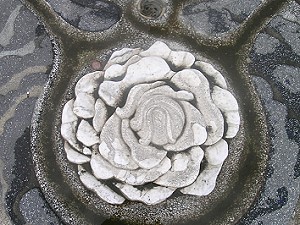 |
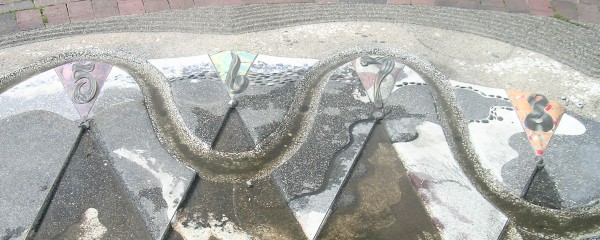
The concrete has a scalloped outline, surrounded by ripples that follow this contour. They look like the fine ripples left on the beach by a calm sea. The sundial is finally contained in a ring of red bricks or tiles. Along the rim the four cardinal directions are being pointed out by hands that are cast onto the drainage covers.
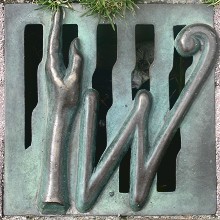 |
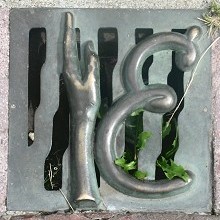 |
Additional drainage points are present inside the sundial face. Still, "the designers could have done a better job of draining the low points" as Dick Tobiason put it.
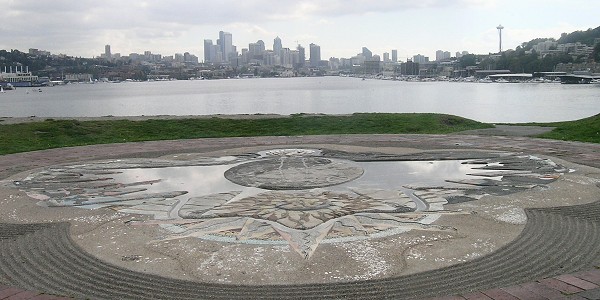
The sundial was constructed in 1978. Erosion by visitors and the natural elements required a restoration, which was completed in 1998. The artists meticulously power washed and ground down various elements of the concrete relief sculpture, replaced and recreated broken bronze elements and found objects, then sealed their work against the elements.
NASS reg.: #74
Location: 47.6° N, 122.3° W
Design: Charles Greening and Kim Lazare
Inauguration: 1978
Information plaque
A bronze information plaque is inserted in the brick pavement. A thumb sticks out as if a painter underneath holds his palette.
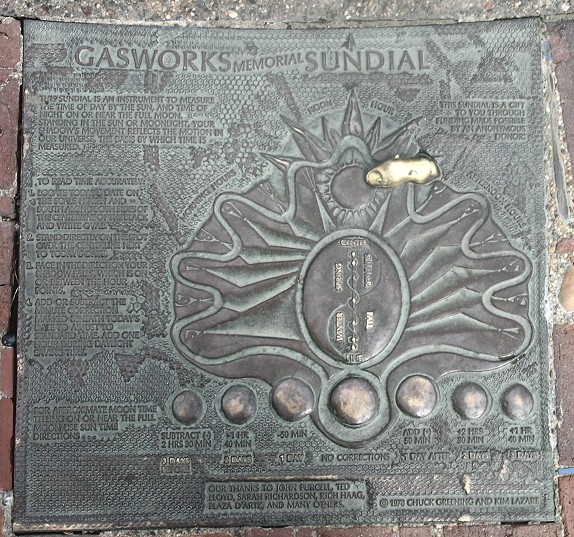
The plaque has a lot of information, so one really needs to be crazy about sundials to read it all. Moreover, the text is fully capitalized, which also does not make for easy reading.
The title runs:
GASWORKS MEMORIAL SUNDIAL.
In the upper right-hand corner:
This sundial is a gift to you through funding made possible by an anonymous donor.
A mysterious message! One wonders whether this anonymous donor intended the sundial as a memorial for an anonymous beloved one, or for the late gasworks...
Below that is a plan of the sundial layout, and to the left are the instructions for use of the sundial:
This sundial is an instrument to measure the time of day by the sun, and time of night on or near the full moon.
Standing in the sun or moonlight, your shadow's movement reflects the motion in our universe, the basis by which time is measured.
To read time accurately:
1. Locate today's date on the scale north and south along both sides of the centerline of the black and white oval.
2. Stand directly on the spot over the centerline next to today's date.
3. Face in the direction your shadow falls, which is on or between the hour points.
4. Add or subtract the minute correction marked beneath today's date to adjust to standard time. Add one hour during daylight saving time.
Below this is explained how the sundial can be used as a moondial, from three days before to three days after full moon. The corresponding moon phases are depicted, full moon coinciding with the rose-like pattern in the plan. The corrections of 50 minutes per day for two and three days after full moon are accidentally switched.
At the bottom are the acknowledgements:
Our thanks to John Purcell, Ted Lloyd, Sarah Richardson, Rich Haag, Plaza d'Artz, and many others.
© 1978 Chuck Greening and Kim Lazare
Special attention should be given to the date scale, as it gives a lot of information. The plaques in the bronze band indicate the beginnings of the zodiacal months. The band further has the calender dates inscribed in small intervals, as well as the combined corrections for latitude (9 minutes) and the equation of time. The feet at the two ends illustrate effectively how to stand on the date line.
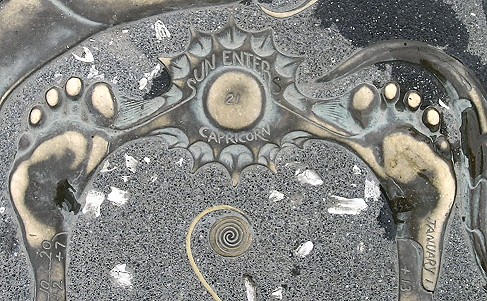
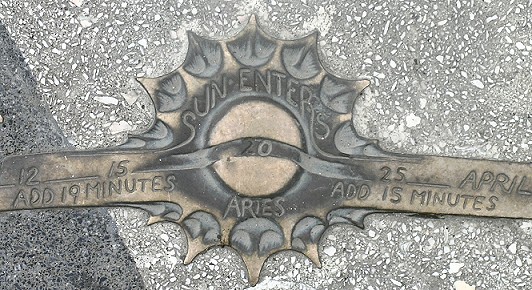
History of the location
Gasworks Park is located at the northern end of Lake Union, a small basin in the center of Seattle. It measures half a mile (800 m) from east to west and somewhat over a mile (2 km) from north to south. In the northeast corner it connects to Lake Washington and in the northwest corner to Puget Sound. The park is easily discernable from outer space, for instance via Google Earth. The arrow points to the sundial.
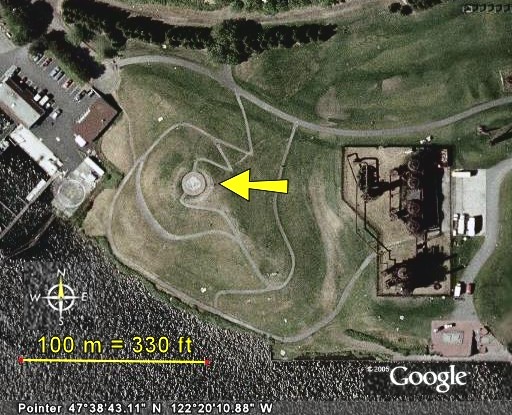
Gasworks Park is a famous case in landscape rehabilitation. The gasworks were in operation from 1907 to 1956. The City acquired the site for a park in 1962. The soil appeared to be too polluted, however. Landscape architect Richard Haag, professor in the Architecture and Planning Department at the University of Washington had the vision to retain the remains of the industrial days. The boiler house has been converted into a picnic shelter with tables and fire grills, and the former exhauster-compressor building, now a children's play barn, features a maze of brightly painted machinery. The surface soil was replaced, and Haag attempted to clear the deep contamination by biodegradation: injection with pollution-loving microorganisms. Whether this method is adequate, is still a matter of debate.
Other features of the park are Kite Hill, the artificial mound topped by the sundial, and a paved shoreline viewpoint. The park was opened to the public in 1974 or 1975 (sources don't agree) and is a very popular place, featuring open-air concerts and Fourth-of-July fireworks.
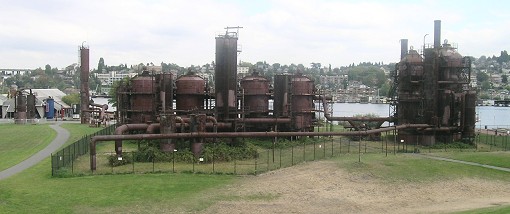
All pictures © Dick Tobiason 2005 unless stated otherwise.